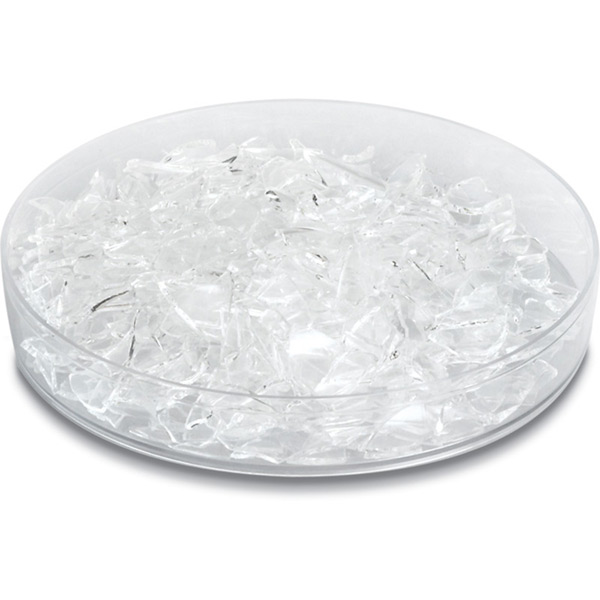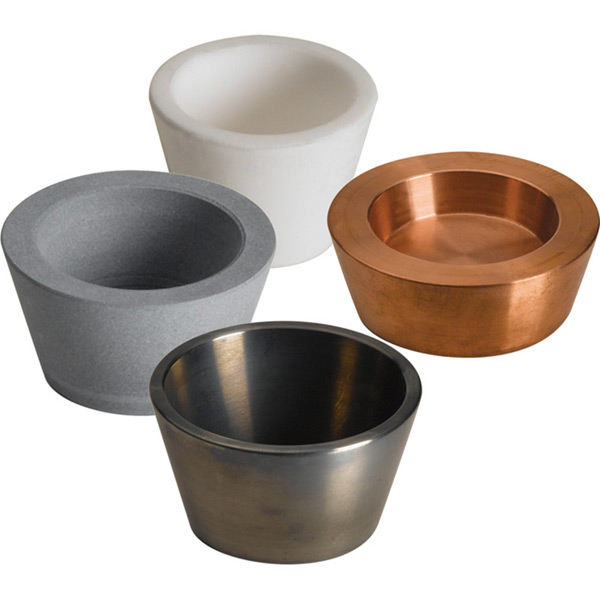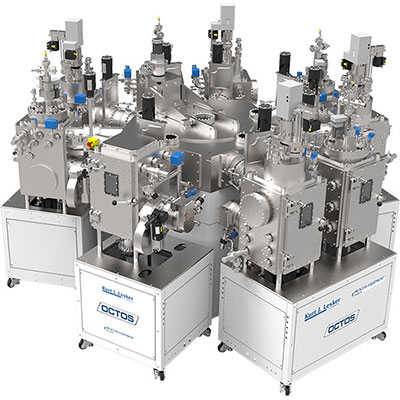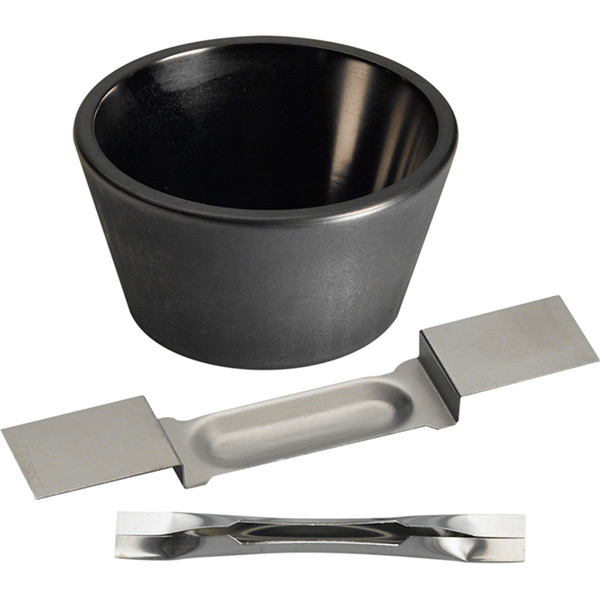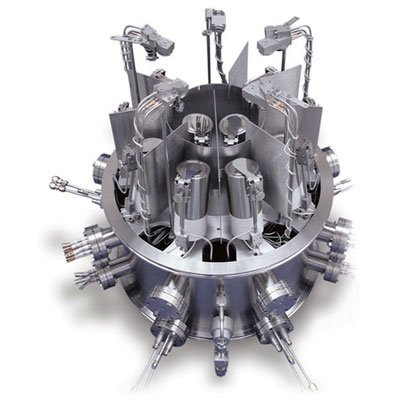Silicon Dioxide (SiO2) Pieces Overview
We sell these pellets and pieces by unit weight for evaporation use in deposition processes. These approximate materials prices are published to provide budgetary guidelines. Actual prices can vary and may be higher or lower, as determined by availability and market fluctuations. To speak to someone directly about current pricing, please click here .
Silicon Dioxide (SiO2) General Information
Silicon dioxide, also known as silica, has a chemical formula of SiO2. It has a melting point of 1,610°C, a density of 2.648 g/cc, and a vapor pressure of 10-4 Torr at 1,025°C. Silicon dioxide is commonly found in nature as sand or quartz. It is primarily used in the production of glass for windows and beverage bottles. It is evaporated under vacuum for the fabrication of optoelectronic and circuit devices.
Silicon Dioxide (SiO2) Specifications
| Material Type | Silicon (IV) Oxide |
| Symbol | SiO2 |
| Color/Appearance | White, Crystalline Solid |
| Melting Point (°C) | 1,610 |
| Theoretical Density (g/cc) | ~2.65 |
| Z Ratio | **1.00 |
| E-Beam | Excellent |
| Thermal Evaporation Techniques | Crucible: Al2O3 |
| E-Beam Crucible Liner Material | FABMATE®, Graphite, Tantalum |
| Temp. (°C) for Given Vap. Press. (Torr) |
10-8: * 10-6: * 10-4: 1,025* |
| Comments | Quartz excellent in E-beam. |
| Suggested QCM Crystal | Alloy Crystal: 750-1002-G10**** |
* Influenced by composition.
** The z-ratio is unknown. Therefore, we recommend using 1.00 or an experimentally determined value. Please click here for instructions on how to determine this value.
**** Suggestion based on previous experience but could vary by process. Contact local KJLC Sales Manager for further information
Empirical Determination of Z-Factor
Unfortunately, Z Factor and Shear Modulus are not readily available for many materials. In this case, the Z-Factor can also be determined empirically using the following method:
- Deposit material until Crystal Life is near 50%, or near the end of life, whichever is sooner.
- Place a new substrate adjacent to the used quartz sensor.
- Set QCM Density to the calibrated value; Tooling to 100%
- Zero thickness
- Deposit approximately 1000 to 5000 A of material on the substrate.
- Use a profilometer or interferometer to measure the actual substrate film thickness.
- Adjust the Z Factor of the instrument until the correct thickness reading is shown.
Another alternative is to change crystals frequently and ignore the error. The graph below shows the % Error in Rate/Thickness from using the wrong Z Factor. For a crystal with 90% life, the error is negligible for even large errors in the programmed versus actual Z Factor.
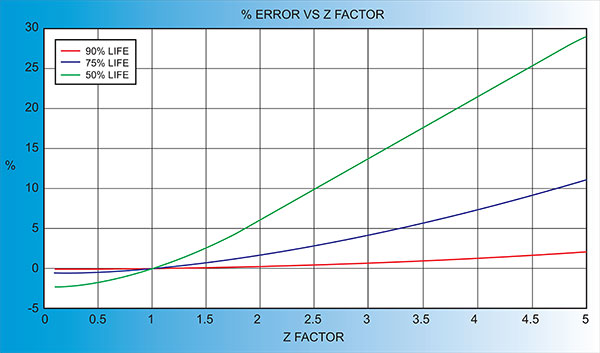
Thermal Evaporation of Silicon Dioxide (SiO2)
We recommend heating the substrate to 350°C before attempting to thermally evaporate silicon dioxide. We anticipate a deposition rate of 2 angstroms per second when the evaporation temperature is at ~1,200°C. A partial pressure of O2 at 1-2 X 10-4 Torr is recommended. Under these parameters, we anticipate films to be smooth and amorphous. The material should be replaced when it becomes dark or black.
Thermal evaporation of silicon dioxide is generally not done due to the difficulty associated with this method. The simplest approach would be to use a relatively inexpensive boat source and change the material as often as possible. We recommend starting with a thick gauge, Tungsten boat such as our EVS20A015W. The other option would be to use a tantalum baffle box, like our EVSSO22. In order for silicon dioxide to sublime and evaporate, the temperature of the baffle box must be between 1,500°C and 1,800°C. Once the material's temperature is within this range, there is potential for the material to alloy with the box, causing it to fail. Silicon dioxide mimics silicon when in the melted state.
Another option would be reactive evaporation. Silicon monoxide (SiO) can be placed in a tantalum baffle box with a substantial amount of oxygen (we recommend adding 1-2 X 10-4 Torr). We have not encountered any problems thermally evaporating silicon monoxide. However, it is necessary to replace the material after every run. Silicon monoxide is hard to convert to silicon dioxide because the bond energy for silicon monoxide is higher than that for silicon dioxide. As with silicon dioxide, the temperature of the baffle box must be between 1,500°C and 1,800°C in order for evaporation to take place. Once the material's temperature is within this range, there is potential for the material to alloy with the box, causing it to fail. Silicon monoxide also mimics silicon when in the melted state.
E-beam Evaporation of Silicon Dioxide (SiO2)
Silicon dioxide is rated "excellent" for e-beam evaporation. The refractive index for SiO2 is between 1.44-1.55. Therefore, this method works well for optical SiO2 films.
We recommend heating the substrate to 350°C before attempting to deposit the silicon dioxide. We also suggest sweeping the e-beam at low power to uniformly fuse the surface of the pieces and to avoid hole drilling. We anticipate a deposition rate of 2 angstroms per second when the evaporation temperature is at ~1,200°C. A partial pressure of O2 at 1 X 10-5 Torr is recommended. Under these parameters, films are expected to be smooth and amorphous with good adhesion. Sometimes, SiO2 films are used as an adhesion layer between dissimilar materials. Material should be replaced when it becomes dark or black.
We also recommend evaporating from a FABMATE®, graphite, or tantalum crucible liner. A key process note is to consider the fill volume of the crucible liner. We find that the melt level of a material in the crucible directly affects the success of the crucible liner. Overfilling the crucible will cause the material to spill over and create an electrical short between the liner and the hearth. The outcome is cracking in the crucible liner. This is the most common cause of crucible liner failure. Placing too little material in the liner or evaporating too much material before refilling can be detrimental to the process as well. When the melt level is below 30%, the e-beam is likely to strike the bottom or walls of the crucible which immediately results in breakage. Our recommendation is to fill the crucible between 2/3 and 3/4 full to prevent these difficulties.
Crucible liners should be stored in a cool, dry place and always handled with gloves or forceps.
Silicon dioxide can also be evaporated directly from the copper hearth of the e-gun. Because of this, some customers prefer to use a pre-machined slug (or starter source) that is directly placed in the hearth pocket. The two main benefits of using a starter source are ease of use and handling as well as superior packing density. Because not using a crucible liner is not always an option, especially in shared systems, some customers will use a copper crucible liner and place the starter source in the copper crucible liner instead of placing directly in the hearth.
KJLC® can produce these starter sources. Contact us by clicking here with your e-gun manufacturer, pocket size, and number of pockets in order for us to produce a quote.
See highlighted results that match your result in the table below.
Ordering Table
| Material | Description | Size | Quantity | Purity | Color | Part Number | Price | In Stock | Add To Cart | |
|---|---|---|---|---|---|---|---|---|---|---|
| Material | Description | Size | Quantity | Purity | Color | Part Number | Price | In Stock | Add To Cart | |
| Silicon Dioxide |
SILICON DIOXIDE PIECES, |
1mm - 5mm Pieces | 1 lb. | 99.99% pure | Clear | EVMSIO21-5 | $112.00 |
|
||
| Silicon Dioxide |
SILICON DIOXIDE PIECES, |
1mm - 5mm Pieces | 100 g | 99.99% pure | Clear | EVMSIO21-5D | $39.00 |
|
||
| Silicon Dioxide |
SILICON DIOXIDE PIECES, |
1mm - 5mm Pieces | 1 kg | 99.99% pure | Clear | EVMSIO21-5KG | $194.00 |
|
||
| Silicon Dioxide |
SILICON DIOXIDE PIECES, |
1mm - 5mm Pieces | 25 g | 99.99% Pure | Clear | EVMSIO21-5A | $33.00 |
|
||
| Silicon Dioxide |
SILICON DIOXIDE PIECES, |
3mm - 12mm Pieces | 1 lb. | 99.99% | Clear | EVMSIO240 | $100.00 |
|
||
| Silicon Dioxide |
SILICON DIOXIDE PIECES, |
3mm - 12mm Pieces | 50 g | 99.99% | Clear | EVMSIO240B | $38.00 |
|
||
| Silicon Dioxide |
SILICON DIOXIDE PIECES, |
3mm - 12mm Pieces | 100 g | 99.99% | Clear | EVMSIO240D | $48.00 |
|
||
| Silicon Dioxide |
SILICON DIOXIDE PIECES, |
3mm - 12mm Pieces | 1 kg | 99.99% | Clear | EVMSIO240KG | P.O.R. |
|




